 United States of America (1918)
United States of America (1918)
Light Tank – 950 Built
Introduction
When the United States of America joined the Allies on the battlefields of France and Belgium in WW1, in April 1917, the US Army Expeditionary Force did not possess any tanks. Their officers inspected the British and French tanks and decided the French Renault FT tank would meet their needs until more British style heavy tanks could be manufactured.
They were loaned some Renault FT tanks and a few British Mk.V tanks for the final attacks of WW1. The French factories were fully committed in producing tanks to meet the needs of the French Army. There was no spare capacity in France to build additional tanks for the US Army.
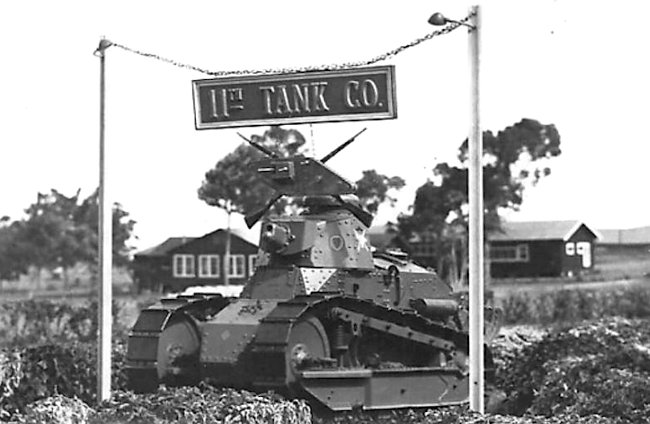
M1917 light tank of the 11th Tank Company in Hawaii, circa 1938. (photo: US National Armor and Cavalry Museum)
The Americans quickly conducted negotiations with the French government and obtained the license to start production of the Renault FT tank in America. For security reasons, the early tanks were just called ‘6 ton special tractor’. Later, they were given the official designation Model 1917 6-ton light tank. This was more commonly abbreviated to just M1917. The US Government placed an order for 4,440 tanks to be built, but only 950 were produced before the order was cancelled.
Only 64 M1917 tanks had been completed by the end of the war. Two M1917 would be sent to France nine days after the armistice on November 20th, 1918 and eight more would arrive in December. None of these tanks would see active service but they were stationed at the Langres tank school.
The letters FT do not stand for ‘first tank’ or the French terms ‘faible tonnage’ (low tonnage), ‘faible taille’ (small size), ‘franchisseur de tranchées’ (trench crosser), or ‘force terrestre’ (land force). It was not named the FT 17 or FT-17 during World War I. That happened after the war finished. All new Renault projects were given a two-letter product code for internal use, and the next one available was ‘FT’. The previous production code was ‘FS’.
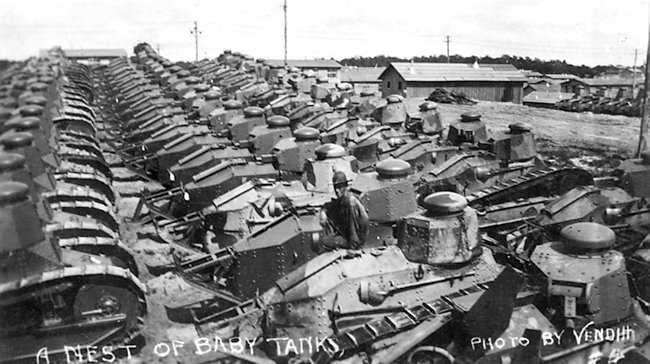
This photograph was taken around 1920. It shows a mixture of camouflaged M1917 tanks (only used in 1919) and M1917 tanks in dark olive drab livery. They are now awaiting issue to the various tank companies of both the regular army and National Guard (photo: Vendith).
Design and Production
This tank should not be judged with modern eyes. Tank on tank combat was not a consideration in the design of this vehicle. The Germans only produced 20 A7V heavy tanks during WW1.
These tanks were the solution to the problem of how do you cross ‘no-man’s land’ under rifle plus machine gun fire and breach the enemy’s front line of trenches. Most of the Renault FT tanks used in the war were only armed with machine guns.
A few were mounted with cannons to deal with fortified bunkers and machine gun positions. They worked with machine gun armed tanks who protected them from infantry attack.
Many books and websites state that the design of the Renault FT armored fighting vehicle was the first to use a turret that traversed 360 degrees. That statement is not true. Before the war and during the early part of the war, turrets were used on armored cars. The Renault FT was the first tank with a turret that traversed 360 degrees to see action on the battlefield.
The tank was operated by a two man crew. The driver sat in the front of the tank in the middle and the commander operated the turret and gun. The turret was unpowered, and had no mechanism to move it, besides handles. The commander had too much to do. He had to look out for enemy targets and dangers, load the gun, traverse the turret, fire the machine gun and give directions to the driver. He also had to read the map and co-ordinate with other tanks and infantry units. The tanks were not fitted with radios, so the commander had to use flags, hand signals and shout commands at other units.
The tank had a number of good design features that were advanced for the time. The front armor plate that protected the driver was slopped. The armor was thin, but slopping increased the thickness of metal any enemy bullet had to pass through before it penetrated the interior of the tank. The angle of the armor also helped deflect incoming enemy bullets. The tank tracks were comparatively wide for the time and this helped enable the tank to cross muddy ground.
The American version
The American engineers made some alterations to the original French Renault FT tank design. Some of these features were cosmetic and others were done to assist in the problem of supplying none standard ammunition and equipment to front line troops.
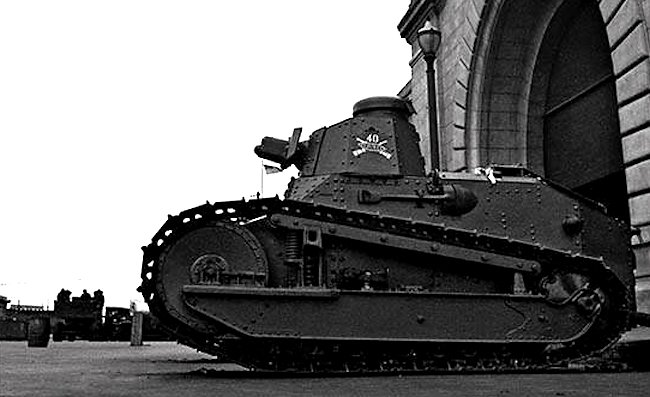
M1917 light tank of the 40th Tank Company, California National Guard, deployed on the streets of San Francisco during the 1934 strike. (photo: US National Armor and Cavalry Museum)
The most noticeable was the removal of the French Hotchkiss 7.9 mm (0.32 in) machine gun. It was replaced by an American made caliber .30 (7.62 mm) 1917 Marlin machine gun that accepted the standard US .30 ammunition.
The US designers changed the engine. The French Renault FT tank was powered by a Renault 4-cylinder, 4.5 liter, thermo-siphon water-cooled, gasoline petrol engine. The Americans replaced it with a Buda HU modified 4-cylinder, with forced water cooling. This gasoline petrol engine produced 42 hp. While the tank wasn’t fast by modern standards, the Buda engine did produce a lot of torque, which was more important than speed, since that would allow it to cross obstacles and rough terrain more reliably.
This initial engine replacement did not enhance the maximum speed of the tank. It still propelled the vehicle at only 5 mph (8 km/h) on the road and it only just managed to keep up with advancing friendly troops across country.
It only had an operational range of 30 miles (50 km) before it needed to be refueled. In modern warfare, this would be a problem, but for Allied tanks involved in WW1 offensives, the enemy front line was only 100 to 200 m away and any breakthrough would normally only cover a maximum of 6 miles (10 km).
The Renault FT and the US Army M1917 tank can be told apart by the following features. The exhaust on the M1917 was positioned on the left hand side of the tank instead of on the right. The machine-gun and 37 mm cannon gun mantlet was replaced with a new design. Solid steel idler wheels replaced the French steel-rimmed, wooden or seven-spoked steel ones on the Renault FT tank.
The American designers added additional vision slits in the armored body work to aid the driver. All US Army M1917 light tanks had polygonal turrets and not the cast metal circular turrets fitted to nearly 50% of French Renault FT tanks.
For those that like to look closer at the differences between different tank types, the frontal armor below the turret on the US M1917 was slightly modified from the original French design. The track tensioning mechanisms, which move the idler wheels forward or backwards, are different. The US Army M1917 tank has an assembly in which a bolt is used to set the tension, and 2 pairs of interlocking toothed plates lock together to hold the axle in place, removing strain from the relatively weak bolt.
A self-starter was fitted to the engine and a bulkhead separated the crew from the engine compartment, as on the FT. It was still very noisy inside the tank and the commander communicated where he wanted the driver to steer by using his feet on the back of the driver: touch the left shoulder to go left: right shoulder to go right: touch the middle of the driver’s back meant go straight ahead.
Manufacturer
The US licensed built M1917 light tank was built at three different factories in America: Van Dorn Iron Works, Maxwell Motor Company and the C.L. Best Company
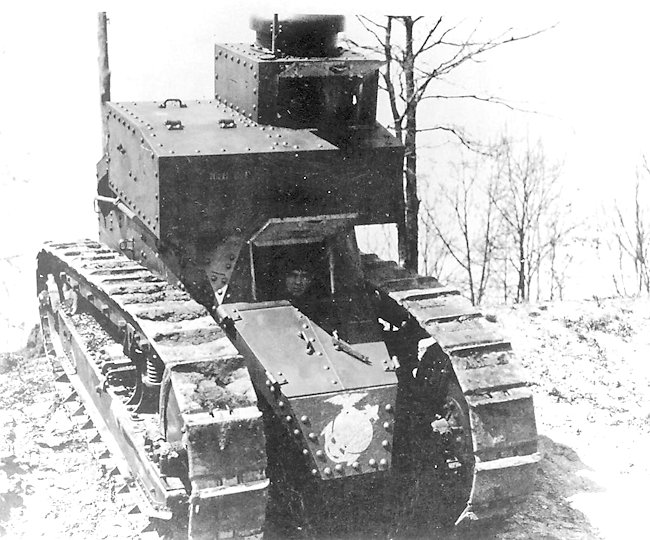
About 50 M1917 signal tank command variants were built. (photo: US National Armor and Cavalry Museum)
The M1917 A1 tank variant
After WW1, the American engineers wanted to fit a more powerful engine into the M1917 chassis, but it was very restrictive. In 1919, they increased the length of the chassis by around 1 foot (30 cm) and mounted an American built Franklin engine that produced 100 hp, which was an improvement on the original US Buda 42 hp engine. It only increased the maximum road speed to 9 mph (14.5 km/h) instead of 5 mph (8 km/h). It was given the designation M1917 A1.
The octagonal turret was used and a caliber .30 M1919 Browning tank machine gun replaced the .30 M1917 Marlin machine gun. All steel road wheels were fitted to this new tank variant.
Some of the US Army tanks were upgraded to gun tanks by the fitting of M1916 37 mm cannons. Each shell was a little bit smaller than the British 6pdr high explosive shell. They could also carry armor piercing shells for punching holes through concrete bunkers. Behind the armor piercing head of the shell was a base detonating fuse system and some black powder which would ignite the primer and charge. It would explode after the shell had hit its target and gone through the concrete or armor.
It carried 238 shells. Two 100-round ammo racks were fitted in the hull, one each side of where the commander stood, plus a 25 round and 13 round ready rack in the turret. This gun tank did not have a machine gun, so it had to rely on other M1917 machine gun tanks for protection from infantry.
The tanks fitted with the caliber .30 M1919 Browning tank machine guns could carry 4,200 .30 caliber rounds. It is believed 374 upgraded 37 mm US Army M1917 gun tanks were built after 1919 and 526 M1917 were fitted with the new the caliber .30 M1919 Browning tank machine guns. They all had the extended chassis and new Franklin engines.
Records show that 50 M1917 signals tanks were built. They had an enlarged non-rotating turret that could carry a radio and space for maps. The French version was called a Renault TSF (telegraphie sans fil = wireless radio)
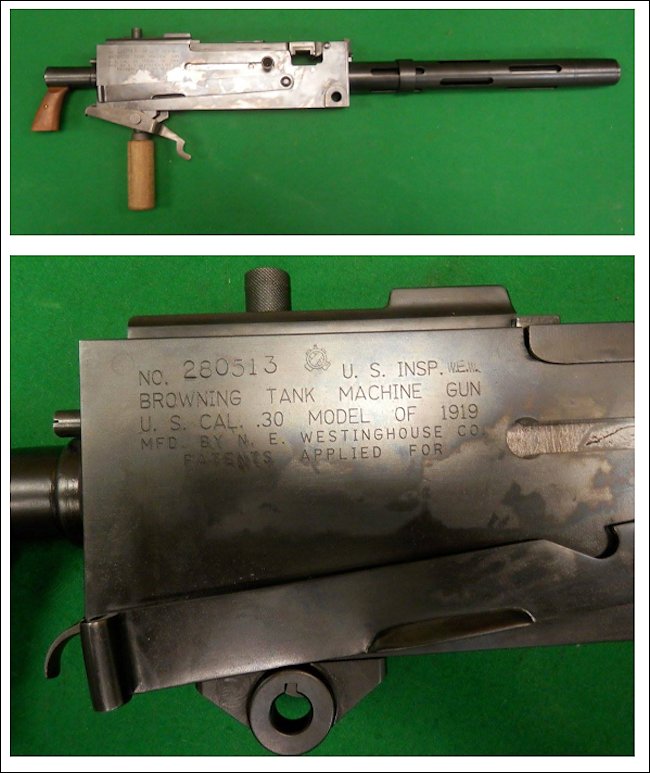
The .30 Cal M1919 Browning Tank Machine Gun. (photo: Allen Bond – Virginia War Museum)
Operational Service
Although 10 American built M1917 tanks were delivered to France in the fall (autumn) of 1918, they never saw action before the end of WW1, on 11th November 1918. It was the tank that would have been used by the US Army in France if WW1 had progressed into 1919 and beyond.
The US Army was already using some loaned French Army Renault FT tanks as well as a few British Mk.V tanks in France during WW1. An American Army light tank platoon consisted of five vehicles that were a combination of machine gun only and 37 mm cannon gun tanks. There was a tank crew height restriction of 5’4″ (1.62 m) or below and a weight limit of 125 lbs (57 kg). If a tanker was taller or larger than this, then he could not fit inside the M1917 tank comfortably and would have had more problems getting out of the tank in a hurry.
The M1917 tank, like the French Renault tank, had a problem with barbed wire wrapping around the tracks and drive mechanism, causing the tank to stop. This left the tank crew vulnerable to concentrated artillery fire. Unlike the British heavy tanks, that would lead the infantry in an attack, the M1917 was used to support the infantry from behind. It needed a barbed wire free lane to be cleared during the night or early in the morning of the attack. The infantry would call upon the tanks to suppress machine gun nests and strong points they could not deal with.
Tanks were used to encourage the American people to buy Liberty Bonds to help with the war effort. M1917 tanks in brightly painted green, yellow and tan livery would put on power demonstrations. Some would demolish a house whilst others would drive through city streets. Victory ‘V invest’ posters would be pasted onto the side of tanks. Special trains were hired to transport the tanks and other pieces of military equipment across the country as part of the money raising project.
For financial reasons, the US Tank Corps was demobilized in June 1920. The tanks were issued to different infantry regiments. The number of working tanks available started to diminish due to accidents, fires and mechanical failures. Some tanks were cannibalized to provide spare parts for other tanks. A few tanks were scrapped, whilst others were ‘mothballed’, kept in storage.
In 1922, the 38th Tank Company, Kentucky National Guard, used some of their Model 1917 tanks to destroy illegal alcohol producing stills during prohibition. These were used in the propaganda war to show the tough stance the US Government was taking against ‘boot-leggers’. The press were invited to take photos of tanks driving over the seized equipment that had been used for making gin and whiskey.
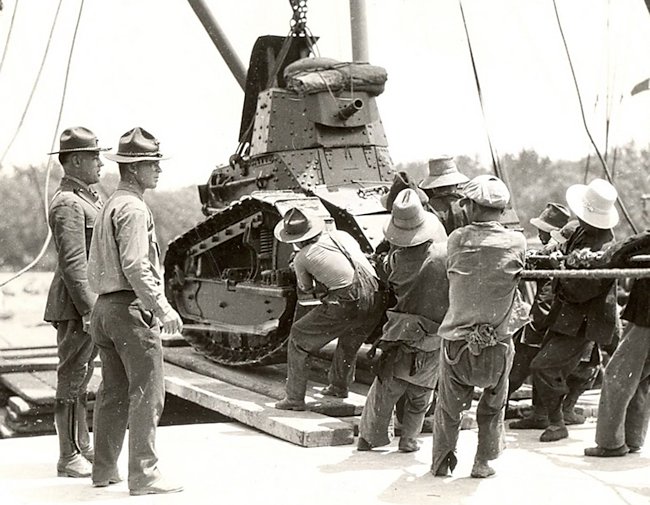
The US sent M1917 tanks to China as part of an expeditionary force in April 1927. (photo: US National Armor and Cavalry Museum)
In April 1927, US Marine Corps M1917 tanks were sent to Shanghai, China, under General Smedley D. Butler, to protect the International Settlement and consulates from the Soviet backed Kuomintang Chinese Nationalist Army and local sympathetic Chinese mobs, which had strong anti-foreigner feelings. The 3rd Brigade of Marines had a total of 238 officers, 18 warrant officers and 4,170 enlisted men. They worked with the British Army Expeditionary force to protect the settlement.
Nationalist forces continued to extend their control northward. American property and people were attacked. General Butler with his entire brigade (less the Fourth Regiment), moved up to Tientsin early in June. The American legation guard at Peking (Beijing) then had a total of 17 officers and 499 Marines. Major conflict was avoided. The situation stabilised and the disorder threat from anti-foreigner demonstrations subsided. All units of the 3rd Brigade of Marines in Tientsin were withdrawn in January, 1929. This included the M1917 tanks. There are no reports of the cannon or machine guns of the US Marine Corps M1917 light tanks being used in anger in China.
In July 1932, six M1917s were deployed in Washington D.C., during the dispersal of the Bonus Army. George S. Patton Jr. states in his diaries that these vehicles were carried in trucks as a deterrent. Photographs of the event show he did not tell the complete story. No shots were fired. During the San Francisco General Strike of 1934, the Governor utilized M1917 tanks of the 40th Tank Company, California National Guard, on the streets of the city. Some of the tanks used during the strikes had their muffler (exhaust silencer box) removed. This would have made the tanks sound very loud. It is not known if this was done as a tactic to increase fear in the civilian demonstrators or not.
A few of the M1917 tanks were used as war memorials around the US. A lot were scrapped and cut up. In 1940, the Canadian Army were offered 250 surplus US M1917 light tanks at scrap value (about $240 each). As a neutral country in the early stages of WW2, US law stated that it was illegal to sell arms to any combatant countries. The Royal Canadian Armoured Corps gained valuable experience and training on them before embarking to Europe and using the more modern equipment. The Canadian Army took delivery of 236 surplus M1917s. Fifteen of them apparently went to Camp Borden for training use, while others went to train individual units such as the Fort Garry Horse and possibly another three.
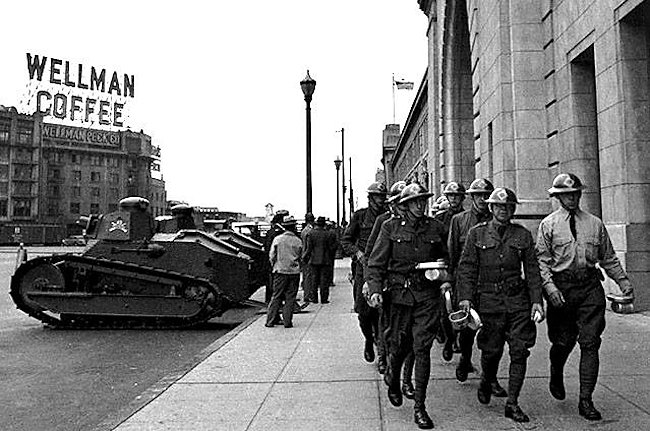
During the San Francisco General Strike of 1934 the Governor utilized M1917 tanks of the 40th Tank Company, California National Guard. Notice the exhaust muffler has been removed.(photo: US National Armor and Cavalry Museum)
Sources
Mr Charles R. Lemons – retired curator of the US Cavalry and Armour Museum
Mr Len Dyer – US National Cavalry and Armour Restoration Shop
Mr Clark Ward – US National Cavalry and Armour Restoration Shop
Early US Armor by Steven Zaloga
The M1917 on Tank-Hunter.com
The M1917 on Wikipedia
The M1917 on Military Factory
Specifications |
|
| Dimensions (L x W x H) | 4.88 (4.02 without tail) x 1.71 x 2.14 m (16’0″/13’2″ x 5’7″ x 7’0″) |
| Total weight, battle ready | 6.7 tons |
| Crew | 2 (commander/gunner, driver) |
| Propulsion | Buda HU modified 4-cylinder, 4-cycle, vertical L-band gasoline engine, 42 hp@1,460rpm. |
| Speed | ~5 mph (8.85 km/h) |
| Range | 30 miles (48 km) |
| Fuel tank | 24 US gallons |
| Armament Female tank | .30 Cal M1917 Marlin machine gun or .30 Cal M1919 Browning machine gun (238 rounds) |
| Armament Male tank | 37 mm M1916 cannon |
| Armor | 6 – 22 mm |
| Total production | 950 |
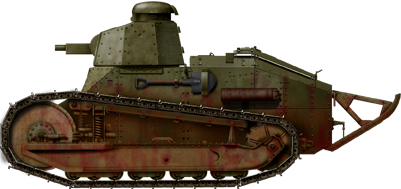
US built M1917 Light Tank armed with a caliber .30 Marlin machine gun
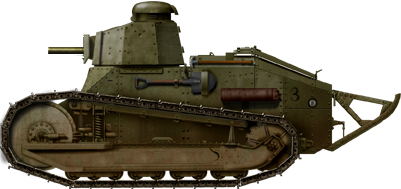
M1917 light tank armed with a .30 M1919 Browning tank machine gun
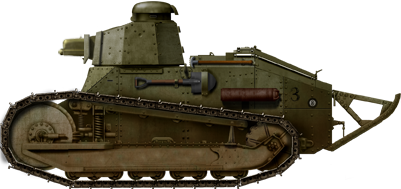
M1917 Light Tank armed with a 37mm M1916 cannon
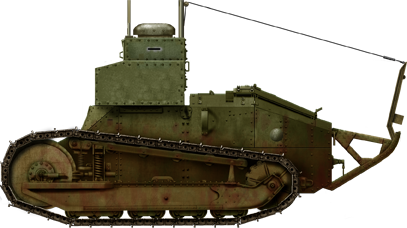
M1917 Signals Tank
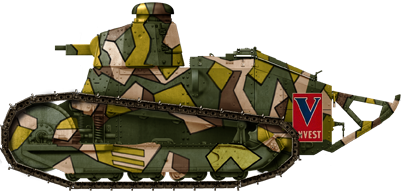
M1917 Light Tank used during the Liberty Bond fund raising event
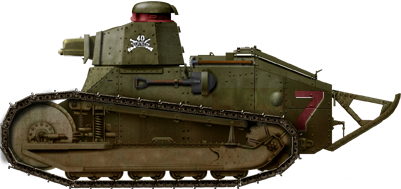
M1917 Light Tank of the 40th Tank Company, California National Guard.
Gallery
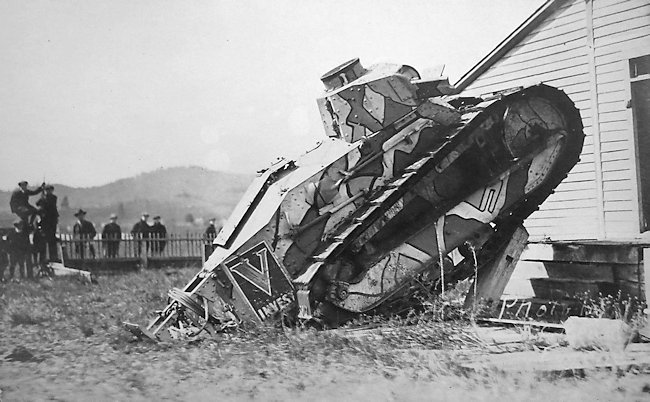
M1917 tanks were used to encourage people to buy Liberty Bonds during and after WW1 to support the allied cause. Subscribing to the bonds became a symbol of patriotic duty in the United States. This M1917 was one of a number of tanks traveling in the 12th Federal Reserve District raising money for the 5th Liberty Loan. Photo taken in Eugene, Oregon 1919. (photo: US National Armor and Cavalry Museum)
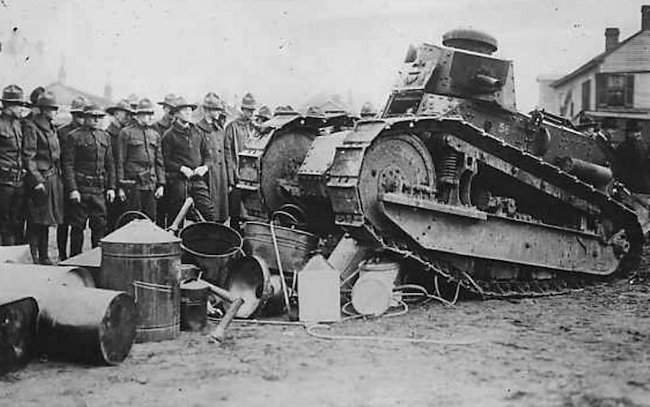
This is a M1917 tank from the 38th Tank Company, Kentucky National Guard. February 21, 1922. It is being used to destroy illegal alcohol producing stills during prohibition.(photo: US National Armor and Cavalry Museum)
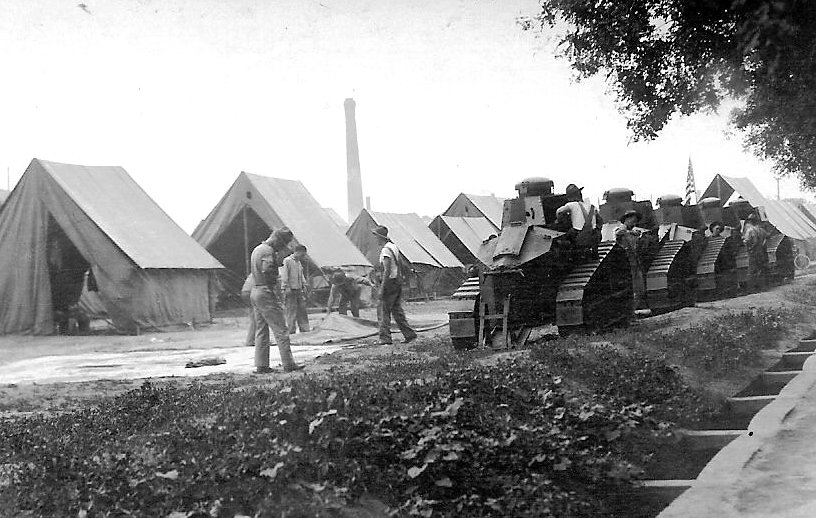
US Marine Corps camp in China. Notice the rear skid is disconnected at the rear of the tank. This is so the tank crew could gain access to the crank engine start.(photo: US National Armor and Cavalry Museum)
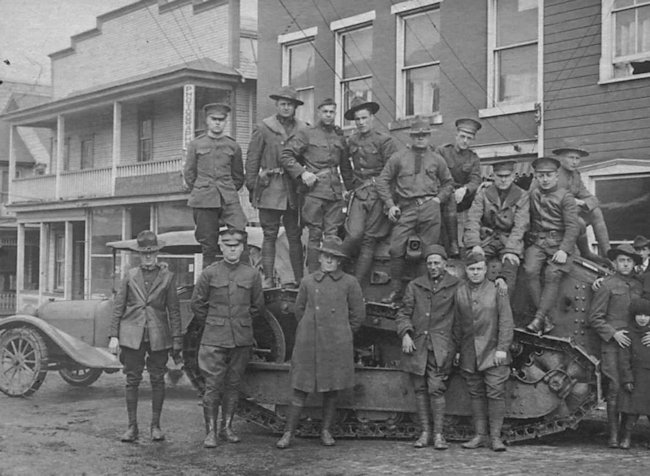
M1917 tank of the 3rd Tank Company, Special Troops, 3rd Division. (photo: US National Armor and Cavalry Museum)
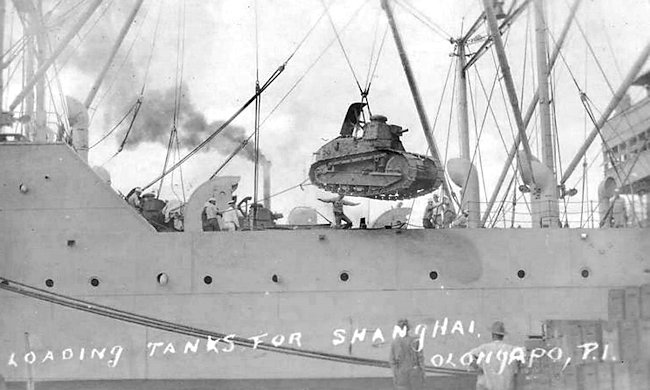
Loading US Marine Corps M1917 tanks on ships for transportation to Shanghai, China 1927. (photo: US National Armor and Cavalry Museum)
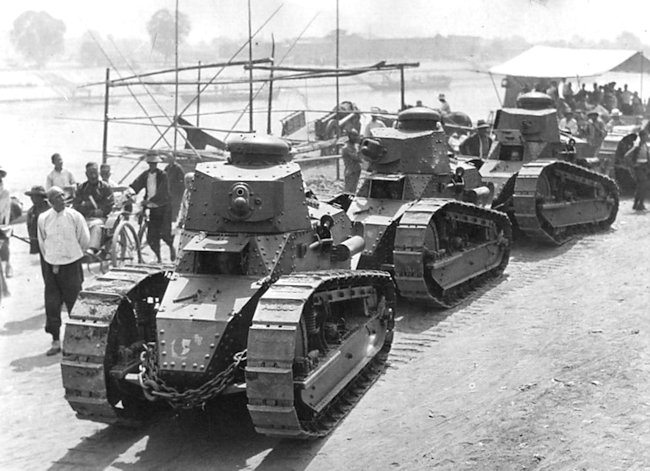
US Marine Corps M1917 tanks in Tients, China in April 1927. (photo: US National Armor and Cavalry Museum)
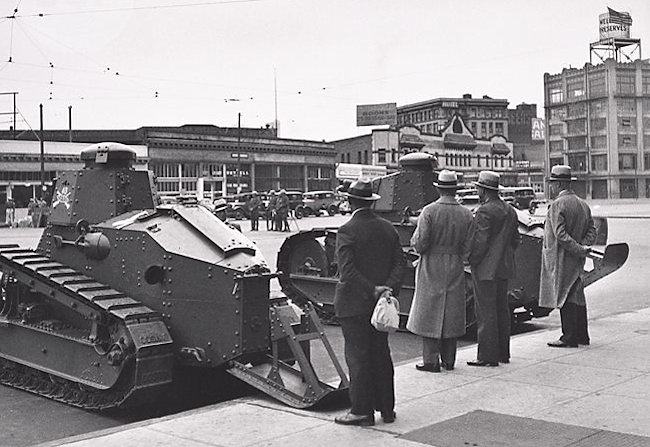
During the San Francisco General Strike of 1934, the Governor utilized M1917 tanks of the 40th Tank Company, California National Guard. They simply performed security and acted as a threat to any strikers. The trench skids have been disconnected to enable access to the crank start at the back of the tank. (photo: US National Armor and Cavalry Museum)
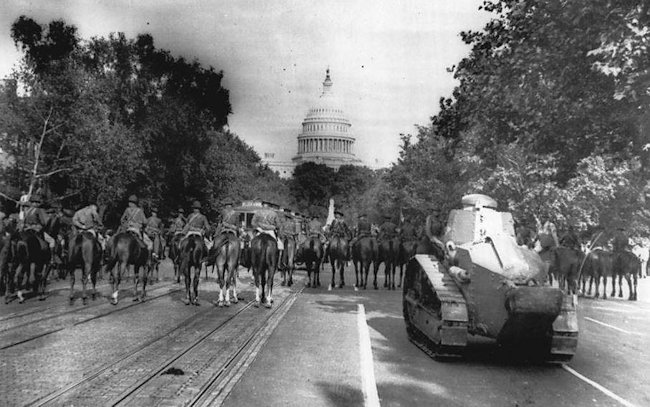
MacArthur deployed M1917 tanks in a policing role at the Bond March in Washington DC. (photo: US National Armor and Cavalry Museum)
Surviving Tanks
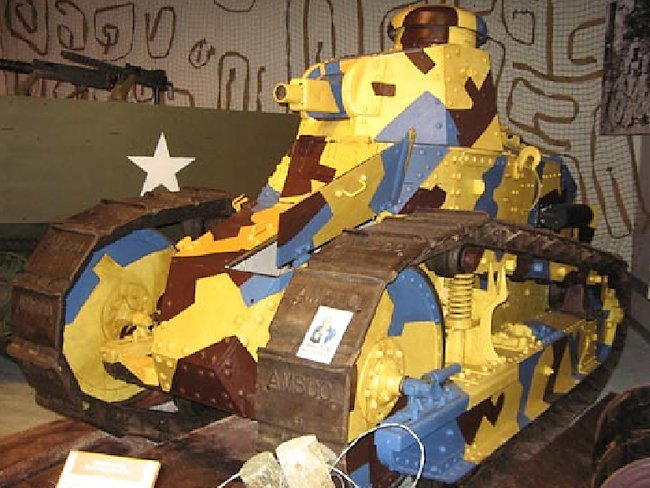
Surviving early production M1917 with Marlin machine gun mount at the Pennsylvania Military Museum, Boalsburg, PA, USA. (photo: Jim McClure)
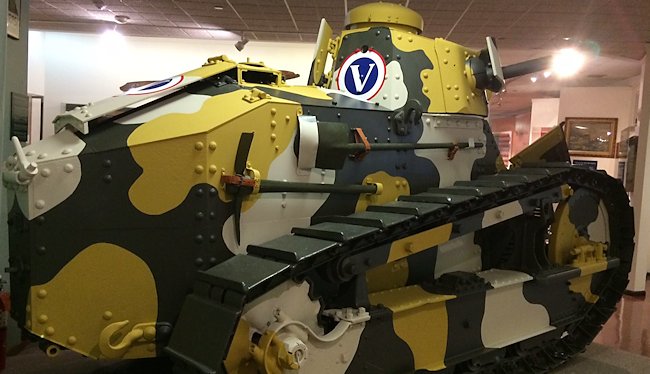
Preserved US Army WW1 M1917 6-ton light tank at the Virginia War Museum, in America, with caliber .30 M1919 Browning Tank Gun fitted. (photo: Allen Bond)
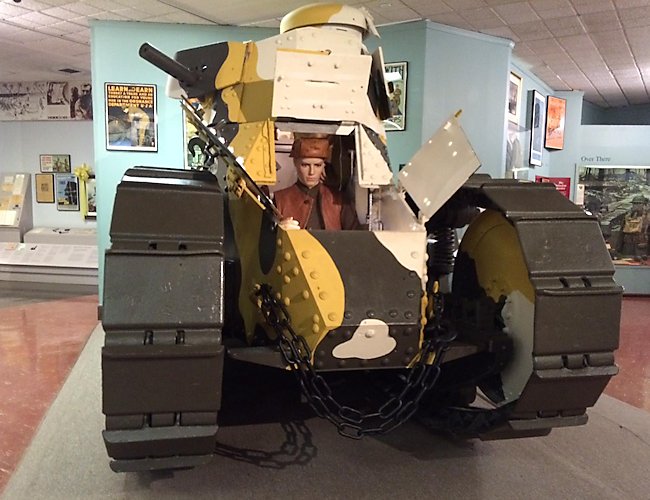
Driver’s position in a US Army WW1 M1917 6-ton light tank. (photo: Allen Bond)
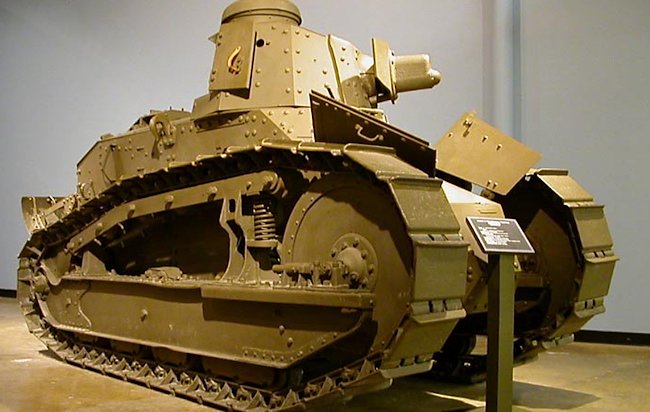
This US Army M1917 tank was fitted with a M1916 37mm cannon and could carry 238 rounds. It is on display at the National Armor and Cavalry Mus, Fort Benning, GA, USA (photo: Roger Davis)
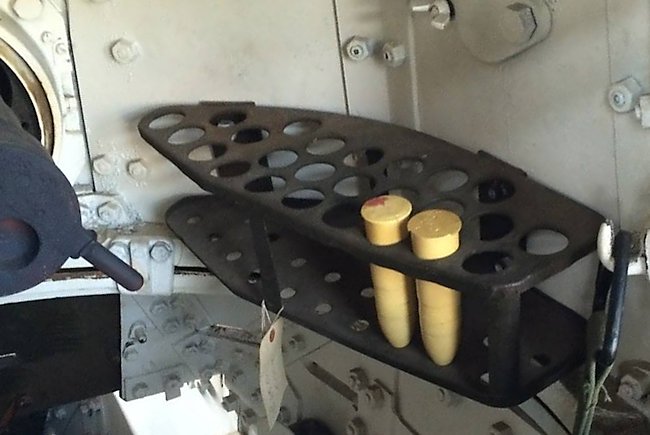
This is the 25 round ready rack in the turret of the M1917. In total the tank carried carried 238 shells. (photo: Clark Ward)
By Craig Moore
The First World War’s fierce battles saw the need to develop military technology beyond anything previously imagined: as exposed infantry and cavalry were mowed down by relentless machine-gun attacks, so tanks were developed. Stunningly illustrated in full colour throughout, Tank Hunter: World War One provides historical background, facts and figures for each First World War tank as well as the locations of any surviving examples, giving you the opportunity to become a Tank Hunter yourself.

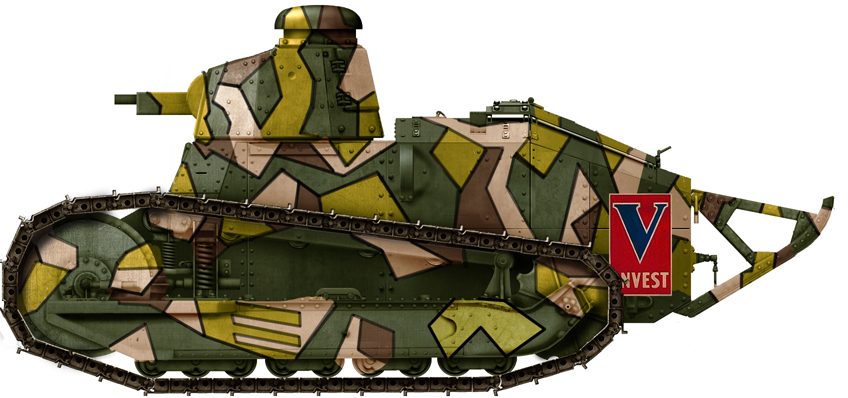

4 replies on “Light Tank M1917”
That M1917 light tank of the 11th Tank Company in Hawaii looks strangely like a model someone made.
Is it a real photo?
I’m looking for the book on the Renaul engine? My state has on the engine need work on it just would like to have some on the engine to help me out?
Sorry Gary, we don’t have access to any such books.
I want to know the cost of the light tank during ww1